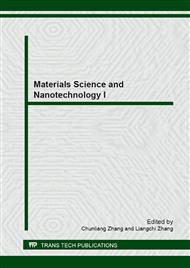p.299
p.303
p.307
p.312
p.317
p.321
p.325
p.329
p.333
Synthesis and Properties of New Biodegradable Polyurethane Containing Natural Rubber and Poly(lactic Acid): Effect of NR and PLA Ratio
Abstract:
Biodegradable polyurethane was synthesized using poly(DL-lactic acid) diol and hydroxytelechelic natural rubber as hydroxyl containing precursor, 1,4-butane diol as chain extender, isophorone diisocyanate and dibutyltin dilaurate as catalyst. Poly(DL-lactic acid) diol was prepared by condensation polymerization of DL-lactic acid using 1,4-butane diol as initiator and stannous octoate as catalyst. Hydroxyltelechelic natural rubber synthesized via oxidative degradation of natural rubber and then reduced carbonyl end group to hydroxyl group. Chemical structure of products was characterized by 1H-NMR. Molecular weight and polydispersity determined by SEC. Thermal properties was characterized by DSC and TGA. Segmented polyurethane show two Tgs and two degradation steps corresponding to natural rubber and poly(DL-lactic acid) segment. Polyurethane containing poly(lactic acid) more than 40%mol are become brittle. This result caused by brittle characteristic of PLA. Moreover, mechanical properties increased as content of PLA increased.
Info:
Periodical:
Pages:
317-320
Citation:
Online since:
December 2012
Price:
Сopyright:
© 2013 Trans Tech Publications Ltd. All Rights Reserved
Share:
Citation:


